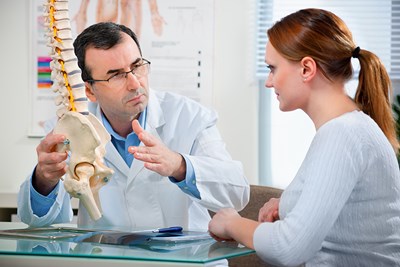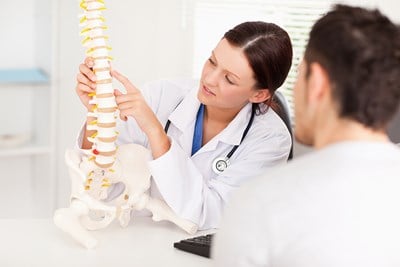Spinal stenosis, a common, but often misdiagnosed medical condition, is identified as the narrowing of the spine—specifically the open spaces occupied by spinal nerves. This narrowing can apply pressure to the spinal cord, which then results in nerve pain that can be felt not only in the lower back, but in the arms and legs as well.
Although some people with spinal stenosis may remain asymptomatic, others can experience neurological symptoms such as pain, tingling, numbness, weakness, and irregular bladder or bowel function. Here is an overview of everything you need to know about spinal stenosis, including symptoms, causes, risk factors, and treatments.
Spinal Stenosis Symptoms
If symptoms do occur, they begin gradually and worsen over time. Because spinal stenosis can be diagnosed in either the neck (cervical stenosis), spine, or lower spine (lumbar stenosis), symptoms vary depending on the location.
The most common symptom of cervical stenosis is tingling in the hands, followed by weakness, numbness, balance problems, and bladder or bowel incontinence. When spinal stenosis compresses the spinal cord in the neck, the symptoms can be serious, resulting in severe weakness in the arms and legs and sometimes, paralysis.
Lumbar stenosis, however, is identified with lower back pain or cramping that can extend to the legs. Pain can be relieved by sitting, leaning forward, or lying down. Pain can be moderate to severe and may come and go or become chronic, depending on the individual.
Spinal Stenosis Causes
The most common cause of spinal stenosis is aging. The aging process can cause degeneration of the spine, resulting in the compression of spinal nerves. Arthritis is another degenerative cause for the condition. There are two types of arthritis: osteoporosis and rheumatoid arthritis. The inflammation caused by both types of arthritis can apply pressure to the spinal cord.
Spinal Stenosis Risk Factors
- Those over the age of 50
- Those born with a small spinal canal
- Those with achondroplasia (dwarfism)
Spinal Stenosis Diagnosis
Consult a doctor if symptoms become persistent. A consultation will include a record of your family history, a physical exam, and an observation of your movement. Tests may then be conducted in order to determine or confirm a diagnosis. These include spinal imaging in the form of an MRI, X-ray, or CT scan. The health of spinal nerves may be tested with an electromyogram. Additionally, a bone scan may be conducted to identify damage or growths to the spine.
Spinal Stenosis Treatment
Treatment will vary depending on the severity of the condition. Noninvasive treatments that can manage the condition may include medicine to reduce inflammation and relieve pain, limitations on activity, physical therapy, or a lower back brace. Surgery will be needed if symptoms affect walking, bowel or bladder function, or problems with the nervous system. Decompression surgery may also be beneficial for some patients.



